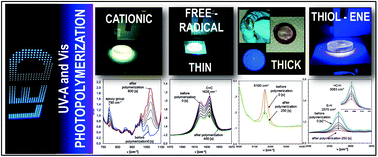当前位置:
X-MOL 学术
›
Polym. Chem.
›
论文详情
Our official English website, www.x-mol.net, welcomes your
feedback! (Note: you will need to create a separate account there.)
New versatile bimolecular photoinitiating systems based on amino-m-terphenyl derivatives for cationic, free-radical and thiol–ene photopolymerization under low intensity UV-A and visible light sources†
Polymer Chemistry ( IF 4.1 ) Pub Date : 2019-10-07 , DOI: 10.1039/c9py01091b Emilia Hola 1, 2, 3, 4, 5 , Maciej Pilch 1, 2, 3, 4, 5 , Mariusz Galek 5, 6, 7 , Joanna Ortyl 1, 2, 3, 4, 5
Polymer Chemistry ( IF 4.1 ) Pub Date : 2019-10-07 , DOI: 10.1039/c9py01091b Emilia Hola 1, 2, 3, 4, 5 , Maciej Pilch 1, 2, 3, 4, 5 , Mariusz Galek 5, 6, 7 , Joanna Ortyl 1, 2, 3, 4, 5
Affiliation

|
The performance of a series of 2-amino-4,6-diphenyl-benzene-1,3-dicarbonitrile derivatives (i.e., amino-meta-terphenyls) as visible light sensitizers for diphenyliodonium salt for enabling photopolymerization at different irradiation wavelengths was studied. The structural modification of a 2-amino-4,6-diphenyl-benzene-1,3-dicarbonitrile compound was carried out. This modification, in the first step, involved a substitution of the amino group for the investigation of the effect of the amine type order on the sensitizing properties of these compounds in a bimolecular photoinitiating system composed of iodonium salt. Furthermore, to improve the spectroscopic properties, which is the scope and size of the extinction coefficient, an additional modification of the 2-amino-4,6-diphenyl-benzene-1,3-dicarbonitrile compound was proposed. The second step of modification consisted of the incorporation of an electron donating group of 4-thiomethylphenyl at the para position into the phenyl ring attachment at the 4-position of the amino-meta-terphenyl moiety. This approach allowed the study of structure/reactivity/efficiency relationships of the investigated meta-terphenyl derivatives as photosensitizers of iodonium salt for the cationic ring-opening photopolymerization of epoxides, free-radical photopolymerization of acrylates in thin films and also in a thick sample of methacrylate blend and additionally for the thiol–ene photopolymerization of allyl and thiol monomers upon UV-A and visible light exposure using Light Emitting Diodes (LEDs) with maximum emission at 365 nm, 405 nm, and 420 nm. Moreover, two different initiation mechanisms were also analysed for bimolecular photoinitiating systems based on 2-amino-4,6-diphenyl-benzene-1,3-dicarbonitrile derivatives with iodonium salt or amine e.g., ethyl 4-(dimethylamino)benzoate through steady-state photolysis experiments, fluorescence experiments, theoretical calculations of molecular orbitals, and electrochemical analysis. Our results showed that 2-amino-4,6-diphenyl-benzene-1,3-dicarbonitrile derivatives have extensive applications in different types of photopolymerization processes across the photo-oxidation or photo-reduction mechanism of their excited species promoted by soft UV-A and visible light.
中文翻译:

新通用的基于氨基-双分子光引发系统米下低强度UV-A和可见光光源阳离子,自由基和硫醇-烯光聚合-三联苯衍生物†
一系列2-氨基-4,6-二苯基-苯-1,3-二碳腈衍生物(即氨基间研究了作为对二苯基碘鎓盐的可见光敏化剂以使在不同辐照波长下光聚合的方法。对2-氨基-4,6-二苯基-苯-1,3-二腈化合物进行了结构修饰。在第一步中,该修饰涉及氨基的取代,以研究胺型有序化对由碘鎓盐组成的双分子光引发体系中这些化合物的敏化性质的影响。此外,为了改善消光系数的范围和大小的光谱性质,提出了对2-氨基-4,6-二苯基-苯-1,3-二腈化合物的另一种修饰。改性的第二步包括在其上引入4-硫代甲基苯基的给电子基团。对位置移动到在氨基的4-位上的苯基环附接元-三联苯的部分。这种方法使被调查的结构/活性/效率关系的研究元-三联苯衍生物作为碘鎓盐的光敏剂,用于环氧化物的阳离子开环光聚合,薄膜中丙烯酸酯的自由基光聚合以及甲基丙烯酸酯混合物的厚样品中,另外还用于烯丙基和硫醇单体的硫醇-烯光聚合使用发光二极管(LED)在365 nm,405 nm和420 nm处具有最大发射的UV-A和可见光曝光。此外,两个不同的起始机制也进行了分析基于与碘鎓盐或胺的2-氨基-4,6-二苯基-苯-1,3-二腈衍生物双分子光引发系统例如,通过稳态光解实验,荧光实验,分子轨道的理论计算和电化学分析获得4-(二甲氨基)苯甲酸乙酯。我们的研究结果表明,2-氨基-4,6-二苯基-苯-1,3-二碳腈衍生物在不同类型的光聚合过程中具有广泛的应用,涉及其受激发的物质通过软UV-光催化的光氧化或光还原机理。 A和可见光。
更新日期:2020-01-02
中文翻译:

新通用的基于氨基-双分子光引发系统米下低强度UV-A和可见光光源阳离子,自由基和硫醇-烯光聚合-三联苯衍生物†
一系列2-氨基-4,6-二苯基-苯-1,3-二碳腈衍生物(即氨基间研究了作为对二苯基碘鎓盐的可见光敏化剂以使在不同辐照波长下光聚合的方法。对2-氨基-4,6-二苯基-苯-1,3-二腈化合物进行了结构修饰。在第一步中,该修饰涉及氨基的取代,以研究胺型有序化对由碘鎓盐组成的双分子光引发体系中这些化合物的敏化性质的影响。此外,为了改善消光系数的范围和大小的光谱性质,提出了对2-氨基-4,6-二苯基-苯-1,3-二腈化合物的另一种修饰。改性的第二步包括在其上引入4-硫代甲基苯基的给电子基团。对位置移动到在氨基的4-位上的苯基环附接元-三联苯的部分。这种方法使被调查的结构/活性/效率关系的研究元-三联苯衍生物作为碘鎓盐的光敏剂,用于环氧化物的阳离子开环光聚合,薄膜中丙烯酸酯的自由基光聚合以及甲基丙烯酸酯混合物的厚样品中,另外还用于烯丙基和硫醇单体的硫醇-烯光聚合使用发光二极管(LED)在365 nm,405 nm和420 nm处具有最大发射的UV-A和可见光曝光。此外,两个不同的起始机制也进行了分析基于与碘鎓盐或胺的2-氨基-4,6-二苯基-苯-1,3-二腈衍生物双分子光引发系统例如,通过稳态光解实验,荧光实验,分子轨道的理论计算和电化学分析获得4-(二甲氨基)苯甲酸乙酯。我们的研究结果表明,2-氨基-4,6-二苯基-苯-1,3-二碳腈衍生物在不同类型的光聚合过程中具有广泛的应用,涉及其受激发的物质通过软UV-光催化的光氧化或光还原机理。 A和可见光。











































 京公网安备 11010802027423号
京公网安备 11010802027423号